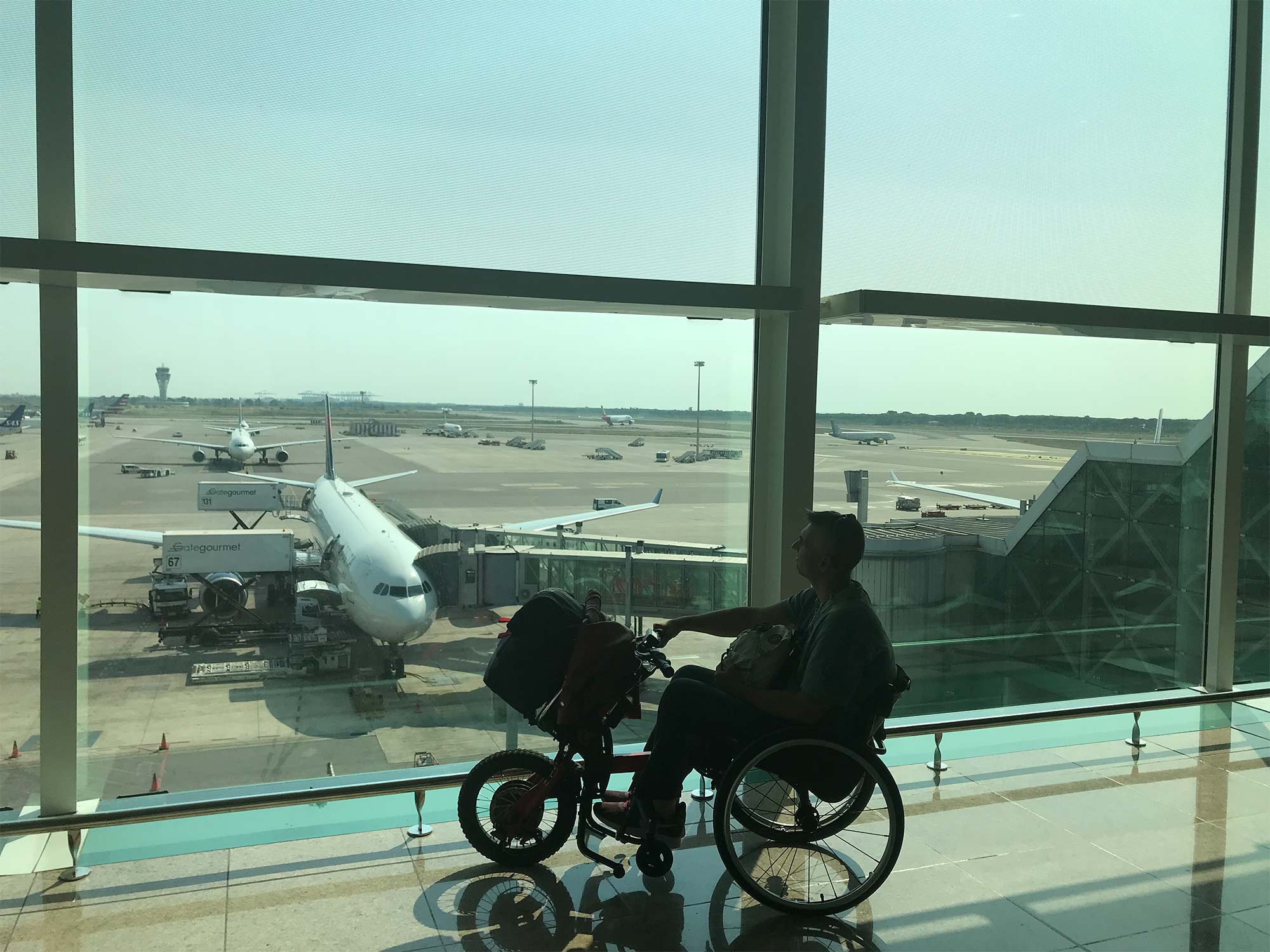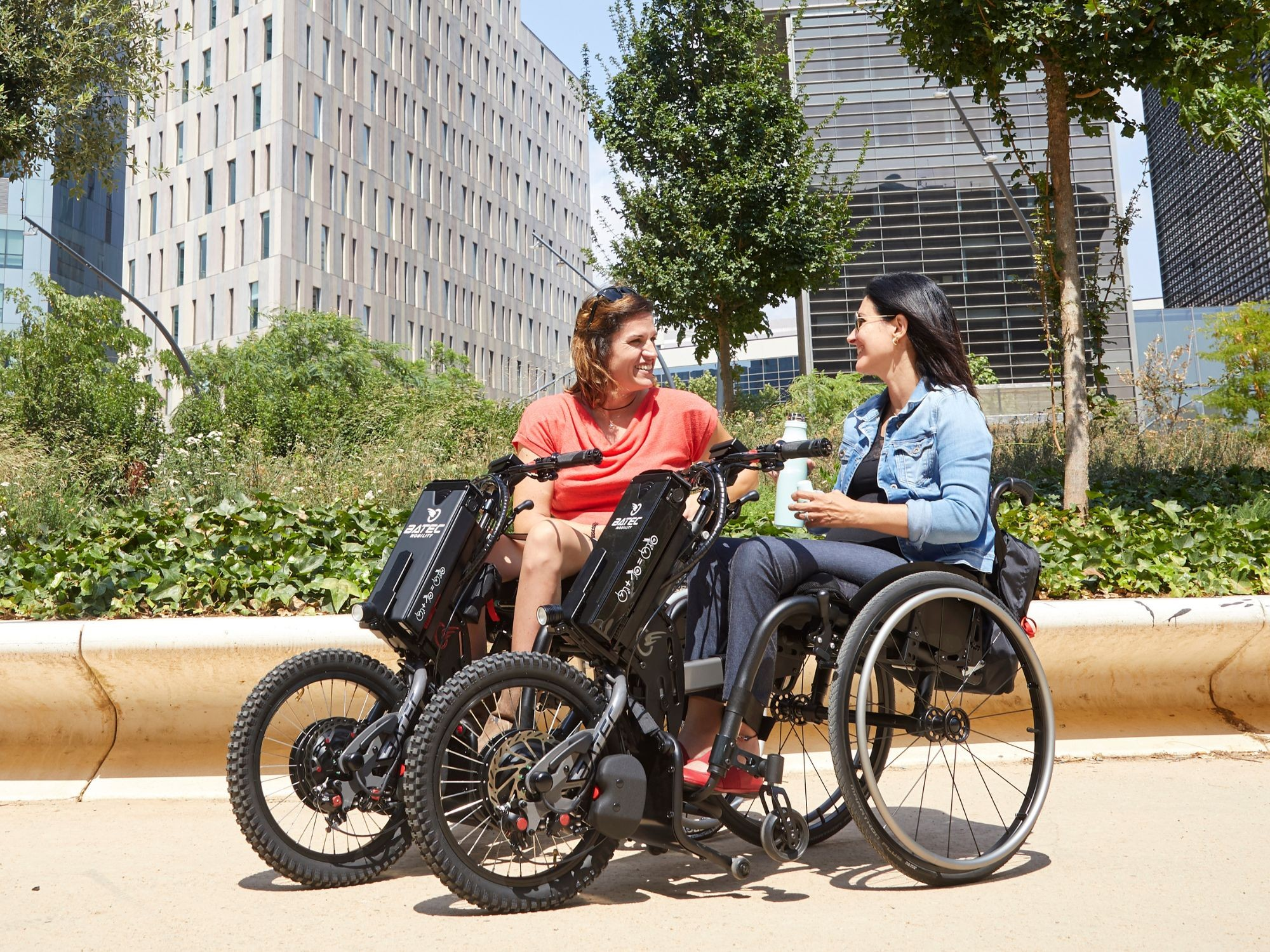Navigating air travel with a wheelchair and handbike attachment is a common concern for people with disabilities or reduced mobility. In this article, we provide you with information, recommendations and useful tips for flying with a wheelchair and your Batec handbike.
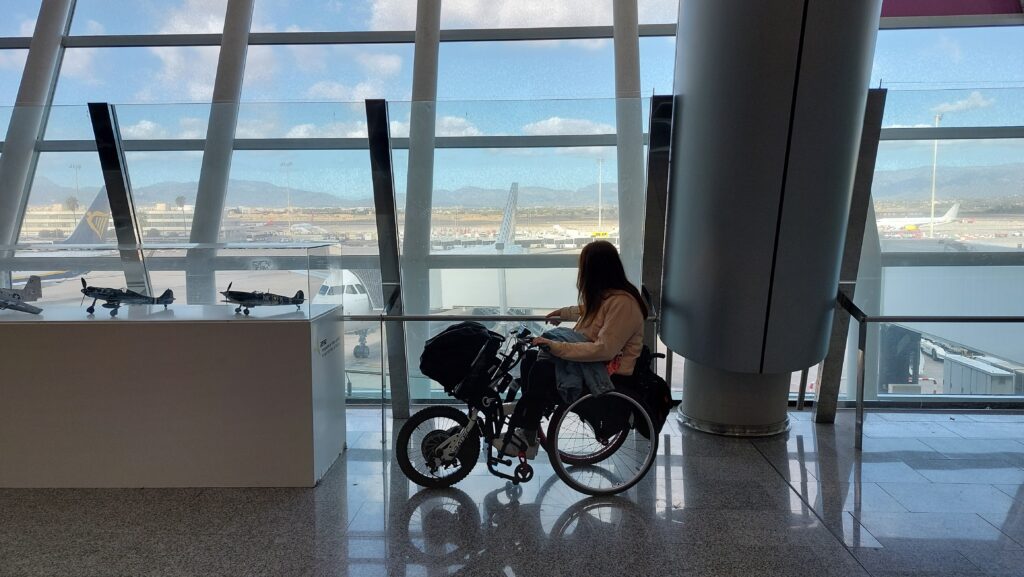
Travelling with a wheelchair and handbike
When travelling with a wheelchair and your Batec handbike, it’s important to note that each airline has its own conditions regarding the weight limit, measurements, and type of travel battery.
Keep reading to find out what you need to know when travelling with a wheelchair and your Batec electric handbike. Further down, you’ll see a list of airlines and their specific terms to help you choose the one that best suits your needs.
Travel battery:
- You must travel with a single travel battery of less than 300 Wh. Luckily, Batec Mobility offers the 280 Wh travel battery, which meets International Air Transport Association (IATA) requirements.
CHECK CURRENT IATA REGULATIONS HERE
- Batec Mobility batteries are made of lithium.
- Be sure to carry the 280 Wh travel battery certificate with you. You’ll need to present it at the check-in counter so that the staff can verify the details. We recommend taking with you at least two copies for the outbound and return journeys. It’s also useful to have the online certificate saved, just in case. You can download it here:
DOWNLOAD BATEC 280 WH BATTERY CERTIFICATE
- The travel battery must travel with you in the cabin. Remove it and carry it protected. If you have a Batec Excursion 2 rucksack, use it to store the battery and charger. We also advise removing the key and storing it securely to keep it safe.
Wheelchair dimensions and weight:
Here at Batec Mobility, we stress the importance of the wheelchair and handbike set travelling together in the hold, securely anchored. To provide our users with precise information, we conducted tests:
-
- Weight: The combined weight of the wheelchair + Batec handbike should not exceed 25 kg. You can use this weight as a reference for travelling safely.
- Dimensions*: Length: 150 cm x Height: 88 cm x Width: That of your wheelchair.
*Weight and measurements based on a lightweight wheelchair + Batec Electric 2 handbike.
Why should my Batec electric handbike and wheelchair travel together? Travelling together enhances stability and robustness, reducing the risk of damage compared to them travelling separately.
If you’re travelling alone and unsure how to anchor the Batec handbike and the wheelchair from the outside or how to give directions, we offer a video for practice before your trip.
Wheelchair travel tips:
- Take your wheelchair and Batec electric handbike for wheelchair to the plane boarding gate to avoid damage or potential loss. Some airlines may ask you to leave your wheelchair with the luggage on the conveyor belt, providing an airport wheelchair to the boarding gate. Try to prevent this!
- Ensure that both your Batec handbike and your wheelchair are checked in. Make sure your handbike and wheelchair are identified separately. Even though they will be travelling anchored, it is safer to have each one identified individually.
- Request that your wheelchair be delivered at the gate, not on the conveyor belt with other luggage. Special assistance personnel will pick you up from the plane seat with a special wheelchair upon disembarkation. If your wheelchair is not at the gate upon exiting the plane, you may encounter two situations:
— Your wheelchair, along with your Batec handbike, has been sent to the special luggage conveyor belt, where items like prams and sports equipment are retrieved. If that’s the case, they will accompany you there in an airport wheelchair. This conveyor belt is separate from the one used for suitcases, designed to prevent damage to this type of equipment.
— Your wheelchair will be waiting for you at the plane exit. When there’s no jet bridge, it’s common to find a van waiting with your wheelchair inside, ready to take you to the terminal.
On the left, there is a check-in and delivery tag on the wheelchair. On the right, the same tags are on the Batec handbike.
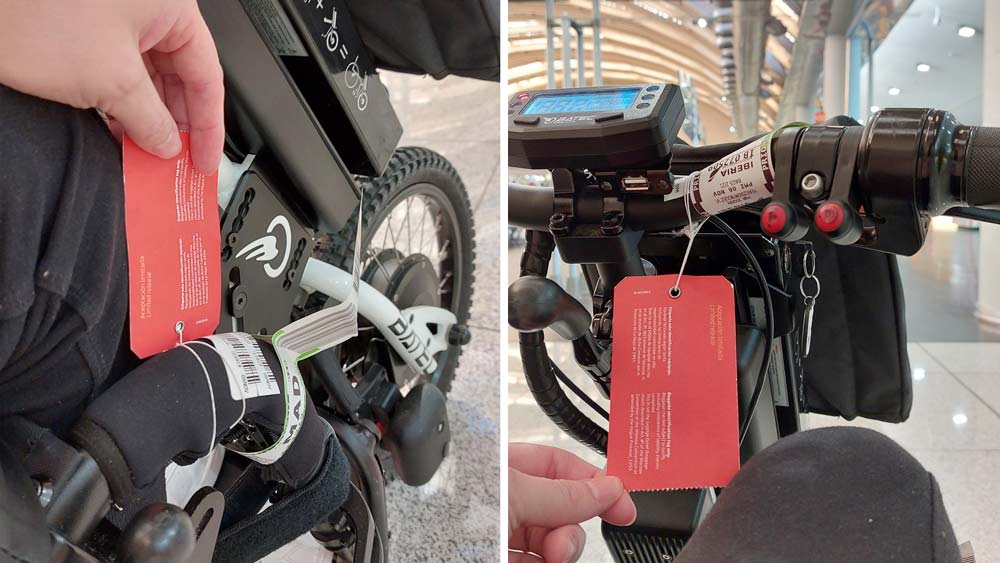
Travel insurance for wheelchair users
One of the main concerns when air travelling with a wheelchair and a handbike attachment is potential loss or damage to your wheelchair or handbike. To ensure your peace of mind, we recommend purchasing a wheelchair travel insurance that covers these scenarios. Here are some options designed for wheelchair users to consider:
- Able2Travel (UK)
- All Clear Travel Insurance (Australia)
- Blue Badge Mobility Insurance (UK)
- Mark Bates Ldt. (UK)
- Good to Go Insurance (UK)
Another option is to purchase generic travel insurance, which can help you find the best coverage for your equipment.
When selecting insurance, ensure it covers not only loss, theft or damage to your equipment but also loss of medication or medical expenses, which are essential considerations.
TIP! Before your flight, take photos of your wheelchair and Batec electric handbike to document their condition prior to boarding in case they suffer any damage.
Booking your flight and PRM assistance
The right to special assistance at airport and on a plane is detailed in Regulation 1107/06 of the European Parliament and of the Council, which became effective on 26 July 2008. This regulation ensures that all persons with reduced mobility are entitled to assistance to air travel with a wheelchair and handbike attachment.
When booking your flight and requesting PRM (persons with reduced mobility) assistance, it’s crucial to:
- Book your flight and PRM assistance at least 48 hours in advance so that the airline can be informed of your special needs and prepare accordingly. You can request reduced mobility assistance when booking your flight and follow up with a call to the airline to confirm everything is in order. It’s recommended to do both to avoid issues upon arrival at the airport.
- Whenever possible, opt for direct flights without layovers to reduce risks for you and your personal mobility equipment. If a direct flight is unavailable, carefully review the connection times. It’s advisable to have a minimum of 2 and a half hours between connections. This is important to avoid missing the flight due to delays and to allow staff enough time to transfer your luggage, wheelchair and electric handbike between planes. During long layovers, try to find a place to rest.
- Upon arrival at the airport, you can either check in independently or proceed to the PRM meeting point, where an assistance person will accompany you from check-in to your seat. This service is free.
- You should be at the disability assistance meeting point at least 2 and a half hours before your flight. Review the terms of the contracted assistance to ensure they meet your needs.
- Each airline has its own terms for people with reduced mobility, so it’s wise to check these before travelling.
Below is a list of major airlines and their information on assistance for travellers with special needs:
Low-cost airlines
- Travelling in a wheelchair with EasyJet
- Travelling in a wheelchair with Jet 2
- Travelling in a wheelchair with Norwegian
- Travelling in a wheelchair with Ryanair
- Travelling in a wheelchair with Transavia Airlines
- Travelling in a wheelchair with Volotea Airlines
- Travelling in a wheelchair with Vueling Airlines
- Travelling in a wheelchair with Wizzair
Regular airlines
- Travelling in a wheelchair with Aer Lingus
- Travelling in a wheelchair with Air Europa
- Travelling in a wheelchair with Air France
- Travelling in a wheelchair with Air Nostrum
- Travelling in a wheelchair with Alitalia
- Travelling in a wheelchair with British Airways
- Travelling in a wheelchair with Brussels Airlines
- Travelling in a wheelchair with Eurowings
- Travelling in a wheelchair with Iberia
- Travelling in a wheelchair with KLM
- Travelling in a wheelchair with Lufthansa
- Travelling in a wheelchair with SAS
- Travelling in a wheelchair with Swissair
- Travelling in a wheelchair with TAP Portugal
– The American association United Spinal Association has created a guide called Navigating the Skies full of tips for your trip.
– Check out Sophie Morgan’s article Accessible Guide to Travel, in which she shares her travel secrets.
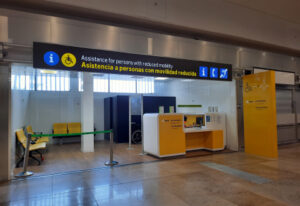
How to fly with a wheelchair
Checking in
When checking in, remember:
- Transporting your wheelchair and accessories is free.
- At the check-in counter, you’ll receive your boarding pass and can check in your wheelchair and luggage.
- They’ll ask for details about your wheelchair or Batec electric handbike, like its travel battery, weight and dimensions. Refer to point 1 of this article for a detailed guide.
- Request that your wheelchair be delivered at the gate, not on the conveyor belt with other luggage. Ensure that both your wheelchair and your Batec handbike are checked in. Find more information in the first point of this article.
- Take your wheelchair and Batec handbike to the plane boarding gate to avoid damage or potential loss.
- Arrive at the check-in counter at least 2 hours before your flight.
- For connecting flights, choose routes with a transit time of at least 1.5 hours.
Flight security check
With PRM assistance, you’ll go through a fast, specific flight security check. If you’re going to the gate alone, look for the flight security check for people with disabilities.
Boarding
- We recommend taking your wheelchair to the gate to prevent damage.
- If there’s no jet bridge, adapted vans will transport you to the plane.
- Your wheelchair goes in the hold. At the gate, airport staff will manually lower it. The battery must travel with you in the cabin.
- You’ll transfer from your wheelchair to a special aisle chair at the gate.
- Qualified personnel will escort you to your seat. You’ll be the first to board. Arrive at the gate early to allow PRM assistance personnel to assist you in time.
In-flight tips
- Use the airport restroom before boarding, as plane bathrooms are not adapted. Limit drinks, especially coffee or tea, to avoid needing the restroom during the flight.
- For long flights without restroom access, consider using a permanent catheter. You can have this inserted in a hospital before travelling and removed in another medical facility at your destination. You can learn to do it yourself if you feel capable.
- Bring a pressure relief cushion to sit on during the flight. Deflate it slightly because the pressure during the flight increases, causing the air cells to inflate. Have the pump ready to inflate it upon landing to avoid problems with pressure.
Last step: Disembarking
When air travelling with a wheelchair and handbike attachment, you will be the last person to disembark the plane. Special assistance personnel will bring a special chair to your plane seat to help you disembark. Your wheelchair will be at the plane exit or sent to the special baggage carousel if transported by van.
Once you have your wheelchair, they will assist you with your luggage, help you through security checks and accompany you to the airport exit.

